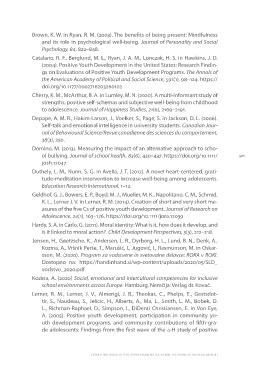Page 521 - Kozina, Ana, Tina Pivec, Ana Mlekuž, Urška Štremfel, Janja Žmavc, Katja Košir, Ajda Mlakar, Martina Zakšek. 2022. Pozitivni razvoj mladih v Sloveniji: razvojne poti v kontekstu migracij. Ljubljana: Pedagoški inštitut, 2022. Digitalna knjižnica, Documenta 22.
P. 521
wn, K. W. in Ryan, R. M. (2003). The benefits of being present: Mindfulness 521
and its role in psychological well-being. Journal of Personality and Social
Psychology, 84, 822–848.
Catalano, R. F., Berglund, M. L., Ryan, J. A. M., Lonczak, H. S. in Hawkins, J. D.
(2004). Positive Youth Development in the United States: Research Findin-
gs on Evaluations of Positive Youth Development Programs. The Annals of
the American Academy of Political and Social Science, 591(1), 98–124. https://
doi.org/10.1177/0002716203260102
Cherry, K. M., McArthur, B. A. in Lumley, M. N. (2020). A multi-informant study of
strengths, positive self-schemas and subjective well-being from childhood
to adolescence. Journal of Happiness Studies, 21(6), 2169–2191.
Depape, A. M. R., Hakim-Larson, J., Voelker, S., Page, S. in Jackson, D. L. (2006).
Self-talk and emotional intelligence in university students. Canadian Jour
nal of Behavioural Science/Revue canadienne des sciences du comportement,
38(3), 250.
Domino, M. (2013). Measuring the impact of an alternative approach to scho-
ol bullying. Journal of school health, 83(6), 430–437. https://doi.org/10.1111/
josh.12047
Duthely, L. M., Nunn, S. G. in Avella, J. T. (2017). A novel heart-centered, grati-
tude-meditation intervention to increase well-being among adolescents.
Education Research International, 1–12.
Geldhof, G. J., Bowers, E. P., Boyd, M. J., Mueller, M. K., Napolitano, C. M., Schmid,
K. L., Lerner J. V. in Lerner, R. M. (2014). Creation of short and very short me-
asures of the five Cs of positive youth development. Journal of Research on
Adolescence, 24(1), 163–176. https://doi.org/10.1111/jora.12039
Hardy, S. A. in Carlo, G. (2011). Moral identity: What is it, how does it develop, and
is it linked to moral action?. Child Development Perspectives, 5(3), 212–218.
Jensen, H., Gøetzsche, K., Andersen, L. R., Dyrborg, H. L., Lund, B. N., Denk, A.,
Kozina, A., Vršnik Perše, T., Marušić, I., Jugović, I., Rasmunson, M. in Oskar-
sson, M. (2020). Program za vodstvene in svetovalne delavce: ROKA v ROKI.
Dostopno na: https://handinhand.si/wp-content/uploads/2020/05/SLO_
vodstvo_2020.pdf
Kozina, A. (2020) Social, emotional and intercultural competencies for inclusive
school environments across Europe. Hamburg, Nemčija: Verlag dr. Kovač.
Lerner, R. M., Lerner, J. V., Almerigi, J. B., Theokas, C., Phelps, E., Gestsdot-
tir, S., Naudeau, S., Jelicic, H., Alberts, A., Ma, L., Smith, L. M., Bobek, D.
L., Richman-Raphael, D., Simpson, I., DiDenti Christiansen, E. in Von Eye,
A. (2005). Positive youth development, participation in community yo-
uth development programs, and community contributions of fifth-gra-
de adolescents: Findings from the first wave of the 4-H study of positive
učinek intervencije pyd-si-program na kazalnike pozitivnega razvoja mladih
and its role in psychological well-being. Journal of Personality and Social
Psychology, 84, 822–848.
Catalano, R. F., Berglund, M. L., Ryan, J. A. M., Lonczak, H. S. in Hawkins, J. D.
(2004). Positive Youth Development in the United States: Research Findin-
gs on Evaluations of Positive Youth Development Programs. The Annals of
the American Academy of Political and Social Science, 591(1), 98–124. https://
doi.org/10.1177/0002716203260102
Cherry, K. M., McArthur, B. A. in Lumley, M. N. (2020). A multi-informant study of
strengths, positive self-schemas and subjective well-being from childhood
to adolescence. Journal of Happiness Studies, 21(6), 2169–2191.
Depape, A. M. R., Hakim-Larson, J., Voelker, S., Page, S. in Jackson, D. L. (2006).
Self-talk and emotional intelligence in university students. Canadian Jour
nal of Behavioural Science/Revue canadienne des sciences du comportement,
38(3), 250.
Domino, M. (2013). Measuring the impact of an alternative approach to scho-
ol bullying. Journal of school health, 83(6), 430–437. https://doi.org/10.1111/
josh.12047
Duthely, L. M., Nunn, S. G. in Avella, J. T. (2017). A novel heart-centered, grati-
tude-meditation intervention to increase well-being among adolescents.
Education Research International, 1–12.
Geldhof, G. J., Bowers, E. P., Boyd, M. J., Mueller, M. K., Napolitano, C. M., Schmid,
K. L., Lerner J. V. in Lerner, R. M. (2014). Creation of short and very short me-
asures of the five Cs of positive youth development. Journal of Research on
Adolescence, 24(1), 163–176. https://doi.org/10.1111/jora.12039
Hardy, S. A. in Carlo, G. (2011). Moral identity: What is it, how does it develop, and
is it linked to moral action?. Child Development Perspectives, 5(3), 212–218.
Jensen, H., Gøetzsche, K., Andersen, L. R., Dyrborg, H. L., Lund, B. N., Denk, A.,
Kozina, A., Vršnik Perše, T., Marušić, I., Jugović, I., Rasmunson, M. in Oskar-
sson, M. (2020). Program za vodstvene in svetovalne delavce: ROKA v ROKI.
Dostopno na: https://handinhand.si/wp-content/uploads/2020/05/SLO_
vodstvo_2020.pdf
Kozina, A. (2020) Social, emotional and intercultural competencies for inclusive
school environments across Europe. Hamburg, Nemčija: Verlag dr. Kovač.
Lerner, R. M., Lerner, J. V., Almerigi, J. B., Theokas, C., Phelps, E., Gestsdot-
tir, S., Naudeau, S., Jelicic, H., Alberts, A., Ma, L., Smith, L. M., Bobek, D.
L., Richman-Raphael, D., Simpson, I., DiDenti Christiansen, E. in Von Eye,
A. (2005). Positive youth development, participation in community yo-
uth development programs, and community contributions of fifth-gra-
de adolescents: Findings from the first wave of the 4-H study of positive
učinek intervencije pyd-si-program na kazalnike pozitivnega razvoja mladih


